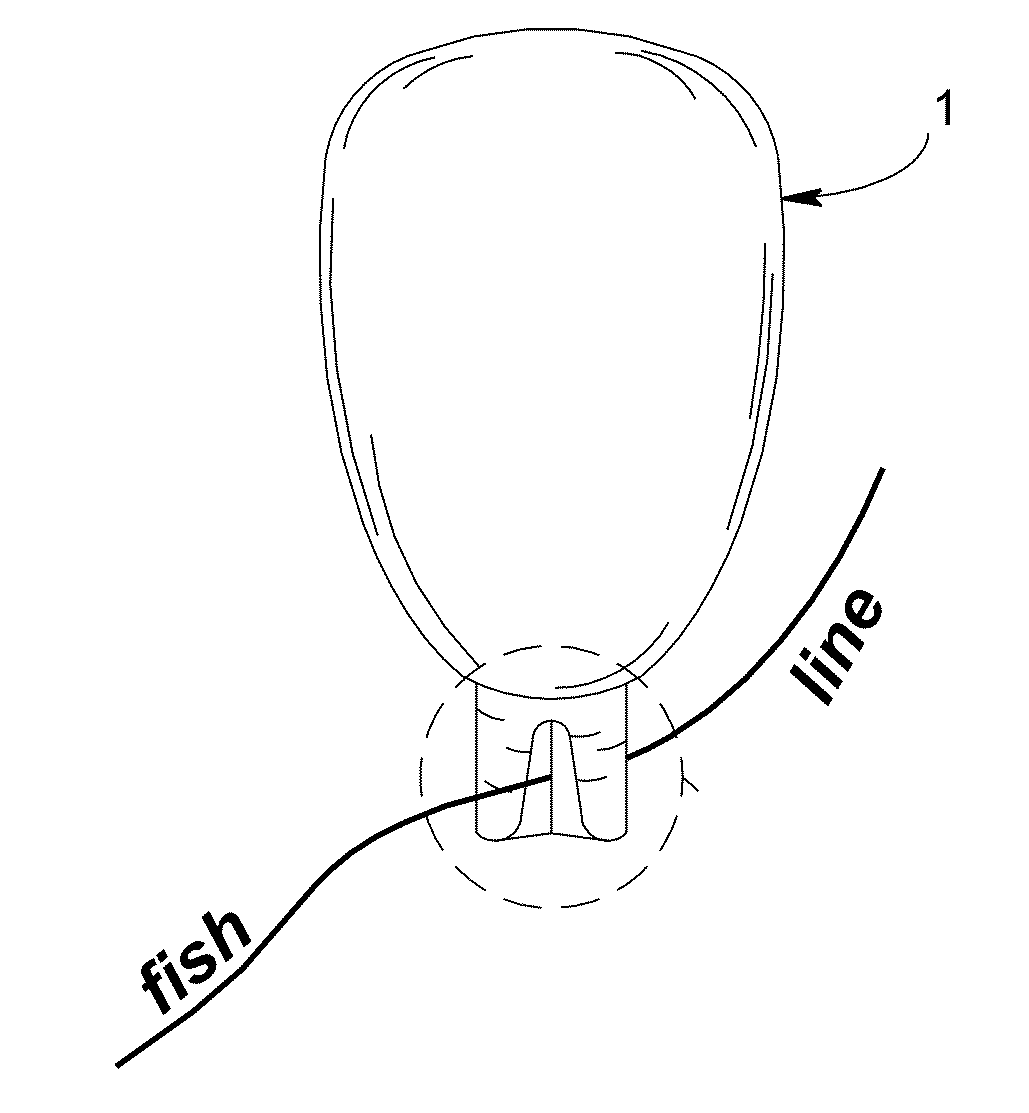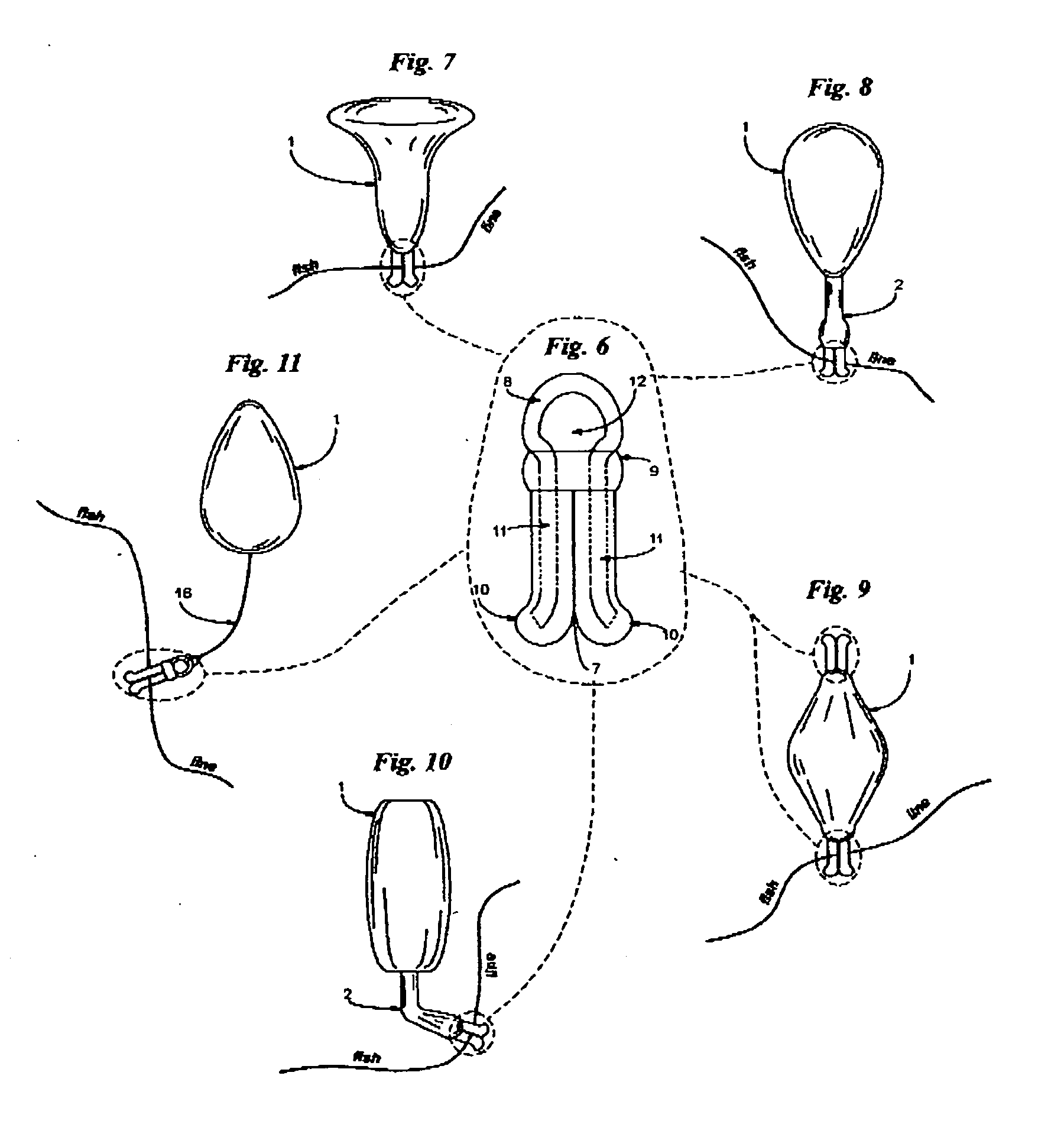[0006]The present invention represents a fishing float device that provides an angler with a simple, yet inexpensive means, of a fish bite indicator, to fish through ice. To attain this, the apparatus utilizes friction to grip the fish line to provide a quick and
effective method of attachment and release, and therefore greater versatility fishing at any depth through ice. The present invention is configured with a buoyant body with one and / or both ends of the body via adhering, molding, and / or tethered by a cord, the system of attachment, enabling the device to slide and / or clamp on and grip the fish line.
[0007]The buoyant body has a variety of shapes, including, but not limited to, spherical egg, tear, oval, round, cylindrical, and cone, and can vary in size. The materials used for the buoyant body, but not limited to, are wood, plastic, and foam that are suitable materials for shaping, with great
buoyancy. Wood materials to be used, but not limited to, are
balsa wood, basswood,
paulownia wood, and
cork oak
bark, which have structural characteristics of being strong, lightweight, easy to shape, and excellent
buoyancy.
Plastic materials to be used, but not limited to, are
polyvinyl chloride,
acrylonitrile butadiene
styrene, nylon,
chlorinated polyvinyl chloride, and
polyurethane that are easily molded into buoyant shapes, and are durable lightweight materials. Foam materials to be used, but not limited to, like
polyethylene,
polystyrene,
expanded polystyrene, and
ethylene vinyl acetate are easily molded into buoyant shapes, and are lightweight durable materials with excellent
buoyancy characteristics. The buoyant body may vary in combination with shape, size, and material, to vary the buoyancy of the embodiment of the present invention for different styles of fishing, giving an angler greater versatility fishing through ice. At one and / or both ends of the buoyant body the system of attachment can be attached via adhering, molding, and / or tethered by a cord.
[0008]The system of attachment stays the same, relative to function, with change of size, shape, and material of the buoyant body. The system attachment is designed in four configurations to create a different gripping action on the fish line, for versatility and different styles of ice fishing. In one configuration, the system of attachment is constructed of a plastic material in a cylindrical form with a set
diameter and length that houses a rubber-type apparatus at one end. At one end of the cylindrical apparatus a bore is constructed perpendicular with a set
diameter, to allow the apparatus to be tethered by a cord, to a buoyant body. At the opposite end and parallel to, the cylindrical apparatus has a bore constructed with a set
diameter and depth. Also at this end, the cylindrical apparatus has two slots formed, parallel, and opposite sides of, with set width and length to accept a fish line.
Plastic materials to be used, but not limited to, are
acrylonitrile butadiene
styrene,
polyvinyl chloride, nylon,
chlorinated polyvinyl chloride,
polypropylene, and acrylic, that are easily molded into shapes, and are durable lightweight materials to construct this cylindrical apparatus. The rubber-type apparatus is designed in a shape, to fit the center diameter of the cylindrical apparatus and be adhered to. The cylindrical apparatus will create compression on the rubber-type apparatus. It is the compression created on the rubber-type apparatus that creates the friction unitized in the function of the system of attachment. A slit through the center of the rubber-type apparatus is constructed to a set depth to accept a fish line. The rubber-type apparatus will be constructed of materials having high elasticity characteristics such as latex,
silicone,
neoprene, butyl, and rubber. When constructed, the slots of the cylindrical apparatus will be fitted parallel to the slit of the rubber-type apparatus, creating the system of attachment. This enables the system of attachment to accept and grip the fish line. This apparatus is then adhered, molded, and / or tethered by a cord, to the buoyant body at one, and / or both ends creating the present invention.
[0009]In the second configuration, the system of attachment is constructed of a spring material in a u-shape forming two legs. The legs are coated with a protective
coating, and are compressed together creating a slit in the apparatus to accept a fish line Where the apparatus is bent forming two legs, a loop is formed. This loop will be utilized to tether the apparatus to buoyant body via a cord. Spring type materials used for this u-shaped apparatus, include, but are not limited to, are spring steels and / or plastics. Spring steels to be used, include, but are not limited to, be stainless steel, and
high carbon steel.
Plastic materials to be used, include, but are not limited to, are
polyvinyl chloride,
chlorinated polyvinyl chloride,
acrylonitrile butadiene
styrene, nylon,
polyurethane that are easily molded into shapes, and are durable. Protective coatings used, include, but are not limited to, are vinyl, latex,
silicone, Teflon,
neoprene, nitrole. Flat and / or round wire forms will be utilized to create different gripping actions on the fish line as well as durability. The spring formed apparatus can be adhered, molded, and / or tethered via a cord to a buoyant body.
[0014]The color of the present invention is important to accommodate the different lighting conditions of the day, when used as a fish bite indicator, fishing through ice. The float colors will be visible through ice, on ice,
snow, and different lighting conditions of the day. The present invention will utilize single colors, and / or multiple colors, to optimize versatility for all lighting conditions.
[0015]As described in the earlier text, the present invention slides and / or clamps onto the fish line in a perpendicular manner securing it at a desired depth utilizes friction and is not fixed to the fish line. It should be reiterated that the ability of this present invention to dislodge from the fish line, at any depth an angler is fishing, gives it an unmatched versatility, as a fish bite indicator for ice fishing.
 Login to View More
Login to View More  Login to View More
Login to View More 


